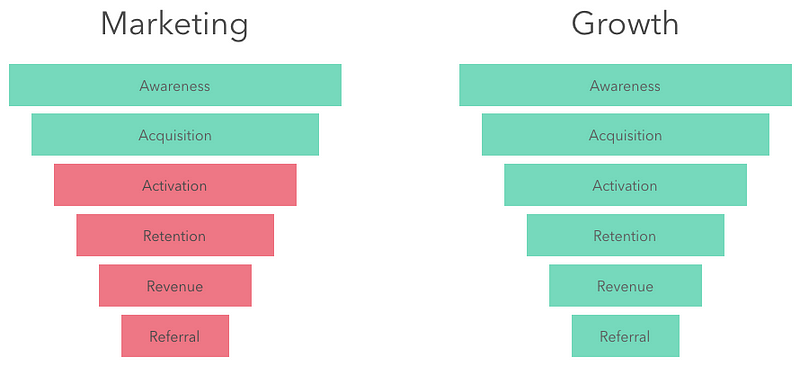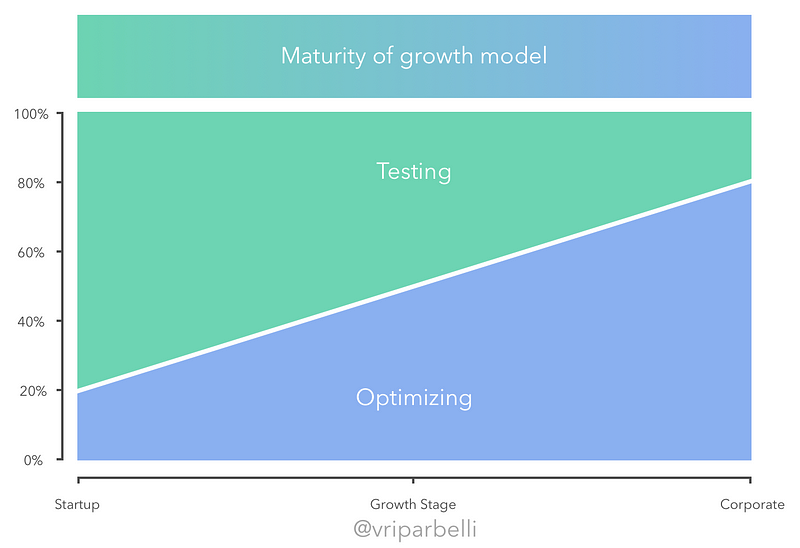A comprehensive roadmap to save you frustration, tears and cool cash.
This is a long read: it’s two and a half year of learnings from being part of starting more than 11 companies with my great colleagues at Founders.
I’ve distilled all this into 7 principles, a 16 minute read, on how to grow a startup — written from the perspective of someone with a background in traditional agencies.
Why should you read it?
If you’re considering to go into startups (or already have) with an agency background you do not want to miss this. It will save you from learning a lot of painful lessons on your own. This guide is written from your perspective.
If you run your own startup you should read this and pass it along to your marketing department. Make sure that this is not webdings to them. If it is you either have a problem or very deep pockets.
If you work in an agency then this piece will hopefully provide some inspiration on how to move fast, break things and think outside the box.
If you’re already working with startup marketing/growth you will probably have discovered some of this on your own. If not, it will hopefully give you some new perspective and save you some tears and frustration in the future.
–
Startups are the cool kid in town. People from all industries are increasingly moving into tech rather than hamster-wheeling their way up the ranks of a Fortune 500 company. Agencies and startups are relatable in many ways and I’ve met a lot of ex-agency people now doing startups.
One thing that I always notice is their frustration that traditional agency tactics does not work in their startup. Especially at the early stages when the uncertainty is high and budgets are low.
Before startups, I worked in agencies and as an independent marketing consultant. I took the journey from executing traditional digital marketing strategies for brands, retailers, etc. to being faced with the daunting, and very different, task of acquiring the first 100 users for a startup.
On the surface, being the ‘digital marketing guy’ in a start-up and in an agency seems like quite similar roles: it’s still about SEM, SEO, social ads, PR, conversion rate optimization and so on.
To some extent the toolbox is the same — it’s how you apply the tools that makes all the difference. And from my experience, the difference in application and mindset is huge; way bigger than people generally imagine.
Based on my own experience of going from a digital agency to a start-up, these are the 7 principles I would have taught myself, if I were to start all over.
Feel free to shoot me questions on twitter @vriparbelli
Let’s dive right in!
The 7 Principles of Startup marketing
- You are now on the product team. If people are signing up to your product but not using it, you have a problem. As a growth hacker, you need to be on top of the product analytics and you need to work on the whole funnel, not just awareness and acquisition.
- It’s a mental battle. There will be times you will be doubt yourself, the product and the team. Let it get to you and set root and you will lose. Instead, accept that there is a huge amount of uncertainty in a start-up. Reduce the doubt by talking to customers and listen to their feedback to give your ideas some direction. Keep an eye on the data and keep testing — always testing until you get it right.
- Avoid premature optimization. Don’t spend too much time optimizing Facebook campaigns trying to achieve that 5% reduction in CAC. The opportunity cost is not worth it at the early stage. Focus instead on trying new things that might make an even bigger difference.
- Don’t look where others are looking. Marketing channels come and go. The big ones become more and more saturated over time. You can’t compete there. Instead, find, hijack or create new channels. Think different and always be ahead of the curve! This might seem difficult to do at first, but if you are able to think about ideas that cross channels and have a clever developer to bounce ideas off, you’ll be surprised what you can come up with.
- Execute, execute, execute. In a startup, you need to be a Swiss army knife, everything has to be done with your likely small team. If you can’t do the ad creative yourself, your designer will have to it. This takes away their focus and could slow down the whole team. This doesn’t mean you need to be a hard core creative or a serious coder, but you should be open to learning new skills, at least to a point where you can test whether any idea or concept you have will actually work (i.e. you should be able to create the minimal viable product). Go with the 80/20 principle.
- Avoid perfectionism and be BOLD. Your focus should be on testing, not on being pixel perfect. And don’t be afraid to polarize. In fact, you should aim to shake up things and divide people. More often than not at bootstrapped startups, it’s the radical/bold changes that can generate the big swings you’re looking for.
- You’re the expert. Most likely, there is no one who will tell you what to do. You are expected to be the expert in the field. And if you’re not, become one!
Welcome to the product team
In an agency, your job is to sell someone else’s product. If the product is no good, your job will be more difficult, but it’s out of your hands. In an start-up, however, the boundaries between marketing and the product development are blurred — particularly for SaaS products.
If your start-up’s product is bad, you have a serious problem. Growth also entails a good deal of product development. It’s your job to make sure that people come back and spend more money and tell their friends.
The figure below explains the difference between doing marketing and growth. In marketing, you work mostly in the top of the funnel doing awareness and acquisition campaigns, while as a growth manager, you need to look further down the funnel.
Bringing people to your website doesn’t matter in the long term if they don’t sign up. Getting users to sign up is a wasted effort if none of them come back. You need to be on top of why your users are churning and take measures to limit this churn and keep users. This also means looking deep into the product as well.
In an agency terms: you will likely be responsible for the desk research, focus groups, customer surveys, product management and channel execution.
That’s a high workload to keep on top of. This is where as a startup marketer you’ll be working a lot leaner than what you’re used to at an agency. For instance, to make a marketing decision in your start-up, you won’t need to invest in incredibly thorough, full insight projects to justify decisions. But on the flip side, in a startup, you might find you are asking yourself the following question, a lot …
It’s a mental battle
Are we selling it wrong or selling the wrong product?
It will drive you crazy. Unfortunately, in the early stages you will most likely remain in this flux for a long time. Unfortunately, the amount of uncertainty in an early-stage start-up can be overwhelming. It’s therefore important to keep a steady sense of direction, even in moments when you are seriously doubting yourself and the company.
On a personal level, a failed agency campaign probably just means an angry boss and dissatisfied customer. However, a failed start-up is a whole different ball game and would mean you losing your job along with going through a great deal of emotional stress. If you let this fear paralyze you, you will lose.
So how do you take action on this and answer your doubts? The key is to keep talking to your customers — they will tell you if they are happy or not with the product. To talk to your customers you could implement Qualaroo surveys, call them up, send them emails or utilize a host of other means, just figure it out. In the words of one entrepreneur:
“If you’re selling the wrong product — the rest doesn’t matter. So until you can confidently say that your product absolutely delights a certain target group — focus on this issue 100% of your time.
Talk and meet with your 5–10 early customers (hopefully you have them — otherwise check here) and figure out a way to iterate on the product until it’s absolutely indispensable for your target group. Then all the next steps are going to be much easier.” Jakob Marovt, Co-Founder of Pipetop.
- Make it a priority to get quantifiable and qualitative insights from your customers.
- Work closely with the product manager. If there is no product manager, make sure you are the voice of your customers when talking with designers and developers!
- Be aware of focusing too much on awareness and acquisition. If 80% of your sign-ups churn quickly, you need to fix that first before pouring additional customers into the funnel.
Rayan Jawad (@RayJaw), Founder of Growth Studio — a marketing optimization and growth hacking agency — has this great, actionable advice for achieving product/market fit:
“Roll the ‘net promoter score’ into your overall strategy and on every major product change, ask your customers this:
“On a scale of 1 to 10, how likely are you to recommend the product to family andfriends?”
Always, always always follow this up with two more questions, which most marketers forget:
1. Why (did you rate this the way you did)?
2. If this product disappeared tomorrow, how disappointed would you be?
Here’s the full details of what to do next. But the gist of it is, if you get a net promoter score of below 8, your focus as a start-up marketer should be to work on the product. If you get a score of more than 8, you’re ready to go full steam ahead with your growth plan.”
Avoid premature optimization
Stop optimizing and start testing
In an agency, you will usually be working with the tried-and-tested channels, such as display, social ads, SEO/SEM, affiliate marketing, etc. In fact, you will usually spend most of your time optimizing:
- A/B testing creatives;
- Extracting data from GA/other tracking software;
- Trying out new keywords;
- Reaching out to new audiences and cultivating those you already have;
- Setting up dayparting, bidding strategies, etc.;
- Managing ad buying on different exchanges;
- …
In a large ad company, this makes sense. You likely already know what works and, if the company is spending $1m on online PPC campaigns, reducing the conversion cost by 5% is a great win.
This is the reason that large companies focus 80% on executing and 20% on testing new things. However, for a start-up, this should be reversed: 80% of your time should be spent trying out new things and 20% on executing those that (sort of) work.
In time, this ratio should skew more towards optimization/execution as you start building a growth model that can yield positive results and that is scalable.
Let’s say you have 20 hours allocated that you can spend either …
1) optimizing your PPC campaigns for a 5% decrease in customer acquisition costs; or
2) testing four new channels by spending 5 hours on each.
Which one should you pick?
Your base CAC will, almost guaranteed, be a lot higher as a start-up with an unknown product under an unknown brand.
The yield, in absolute numbers, should give you a hint on where you should prioritize.
You should be able to get three new customers (the yield of optimising on the startup budget) easier by picking up the phone. Testing new channels will provide you with much more insight and hopefully guide you towards the big win, driving you towards a scalable growth model that you could then start optimizing for real growth.
I’m not telling you to neglect optimizing, of course — but have the above in mind before you start spending days on negative keywords, dayparting and other micro-optimization activities.
“It’s always painful to sit in a board meeting and listen to a company miss the forest for the trees — i.e. even if they make all these incremental improvements that the entire company is focused on, they’re going to end up at 2X, and they need to get to 100X.” Sam Altman, Y Combinator
- Don’t get hung up or lost in the details. You need to move fast!
- If you have something that works, by all means optimize it. But do the cost/benefit first!
Don’t look where others are looking.
So what do I test?
The freedom to experiment in a startup is obviously different to working in an agency. In an agency, you’re probably not going to suddenly create WhatsApp groups for your customers or to scrape all your competitors’ data to flip it against them in a PR stunt. However, in a startup, experimenting is key. Therefore, it is essential to:
- Keep on top of the newest digital channels;
- Find the backdoors… Don’t be afraid to violate/bend ToS of the big players!
- Focus on generating insights that will help you improve acquisition activities;
- Not limit yourself to online (also do things that don’t scale).
Be first on new channels. The first banner ads on the internet were incredibly effective: they saw CTRs of 80%. Today, we’re down to 0.06% on average. In a start-up, you don’t want to be spending too much time on these highly competitive channels. Be ahead of the curve.
This graph by James Currier explains the issue very well:
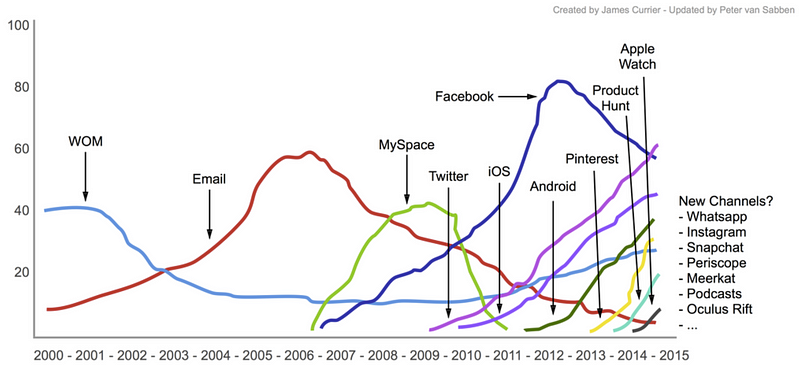
You are probably aware of the constantly re-hashed growth tactics that more or less built the below companies:
- The Dropbox referral system;
- AirBnB scraped Craigslist;
- TupperWare introduced the ‘real-life’ affiliate model;
- Tinder focused their efforts on fraternity boys and sorority girls from the same university;
- Harrys made a super-viral video;
- …
Don’t try to replicate these, unless, of course, they are spot on for you business. These case studies are great for sparking imagination but what works for them will most likely not work for you. Keep in mind that most of these tactics have a limited lifespan. For instance, Hotmail’s ‘PS. I love you’ footer hack worked for them but now it’s been done, it’s unlikely to work again with another company.
These worked well because the methods were new at the time and the product/channel fit were spot on. Nowadays, everyone has a referral system, even ‘single-player’ products with no social interactivity embedded. So don’t get blindsided. Few people still share on Facebook and refer their friends to services — and when they do it’s often for a very good reason.
The most important thing is to have a process!
In Founders, we quickly saw ourselves getting into the mindset of testing, but lacking the tactics to succeed. The nature of early stage growth is chaotic and to not get lost in the wilderness, we needed a process that would help us prioritize correctly.
Therefore, we built the Growth Machine Framework (free download) to implement in our companies. I suggest you either use our template or create your own.
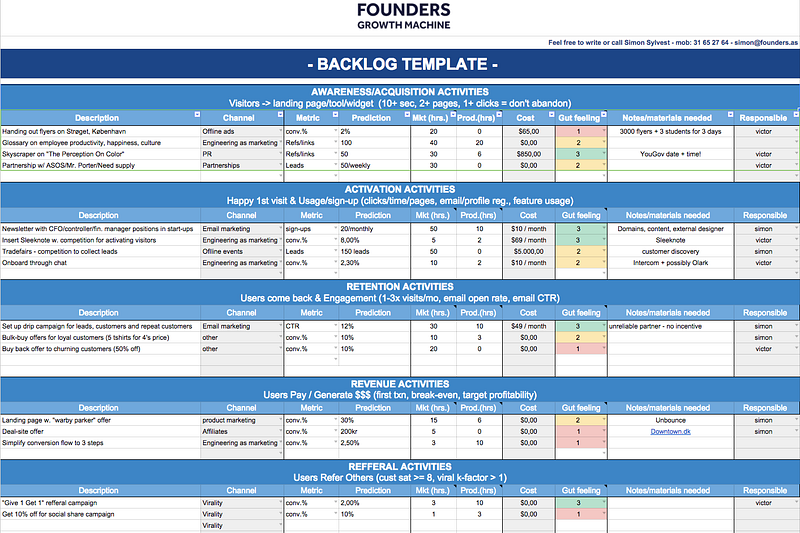
For a detailed breakdown of the growth machine, read here.
When things are working, double down — but keep testing and optimizing. Until you find that one channel that works 50x better than your other activities.
Execute, execute, execute.
Be the Swiss Army Knife
You need to be able to execute by yourself. Bringing a great sense of business or marketing is good, but you don’t want to be the ‘manager’ sitting in the middle of the room who is not able to do anything by himself. In the start-up world, you simply cannot afford to not get your hands dirty — even from a commercial point of view. Get hands on, and stay hands on!
The developers and designers are busy building the product, and if you keep on asking them for help with small tasks, you will quickly become a burden and slow down their work and the whole development team. You should be focused on at least creating an MVP that can prove or disprove whether it’s worth involving the wider business in developing a more scalable solution.
In an agency setting, you usually have design/dev resources available at your disposal — and it’s often the customer that ends up paying for the hours you use to finish a project anyway.
A good start-up marketer has to be a Swiss army knife: good at a lot of different things, expert in a few. In reality, that is probably a bad metaphor because a Swiss army knife isn’t really great at anything — but you get the point, right? It gets the job done — and that’s all you need to do.
Launching campaigns, building landing pages, PhotoShopping ad creatives and pushing it out should not scare you off. Practical skills are key. Hopefully you should be decently prepared if you are coming from an agency background.
Brian Balfour argues that you should aim to become a T-shape, illustrated by the model below. I agree. Learn as many of these as possible.
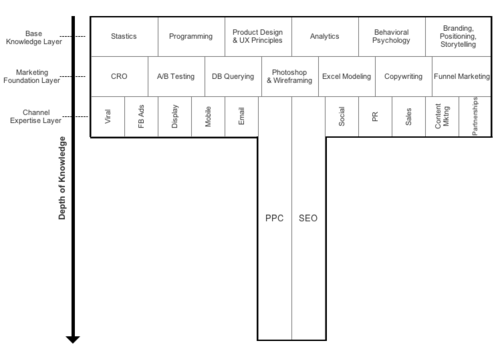
The good news is that there are a billion tools out there to make things easier. Producthunt.com should be an ‘always-on’ tab on your browser to find ways of making this process easier
Also, outsource if you have to. Or just learn the basics — you will be surprised how far you can get by spending a few days in PhotoShop. Start off copying others’ stuff. It will focus your learning on execution rather than on the aesthetic artistry. Run it through your designers and have them critique your work. Remember:
- The 80/20 principle really applies here. Pick up the basics and get help with the rest if you must.
- Most importantly — become an expert in learning. Read some stuff by Tim Ferriss.
My colleague Simon Sylvest covered this topic in length: If I can’t build a product, what good am I?
Avoid perfectionism and be BOLD
You have no brand. And nobody cares about you.
Be bold and push content that is not perfect. Again, remember the 80/20 rule. This is arguably the biggest change from a traditional agency environment. Start-ups get the Law of Diminishing Returns — the fact that you probably only need less than half the insight a traditional agency would strive for to actually be able to generate commercial value from it. Get comfortable with this.
I asked Rachel Ma (@rachelclma), who also made the switch from agency to startup, what she perceived as the biggest difference:
“Experiencing what it means to “fail fast”, which is something that doesn’t really exist in the agency world. I struggled with this idea during my transition because I took it as personal failure instead of understanding it as part of a process.” — Rachel Ma.
In a start-up speed is key: the speed in gaining some insight, creating an MVP to test, implementing it and rolling out the winners. You need to do a lot in a short amount of time. There is no time for perfectionism. There is a mantra in the startup world that you should “move quick and break things”.
It’s a good mantra, so follow it and avoid agency-overthinking. It does not matter that your landing page design is not perfect or that the copy is not 100% as you want it. You need to fail fast.
Embrace the testing mindset: throw it against the wall and, if it sticks, start perfecting it. It’s a shame to spend two days perfecting something that does not work. You can be sure that the lack of success was not because that shade of orange was not exactly as you would have liked it.
You also need to be bold. You have no brand and thus no brand equity to erode. When working with large companies in an agency, you have to be careful with your messaging. You have to be politically correct, don’t go off brand, don’t throw shots at anyone blah blah blah….
This is your advantage as a start-up. Don’t be afraid to take a stand, be bold in your messaging and do something provocative. A company that I think nailed this quite well is TransferWise.
The worst case scenario is that there is an exclusively negative reaction. And in that case, it will be forgotten the day after. No one really cares about your startup at this stage. Plus you probably got some free backlinks anyways… like when SuperGurl decided to do a ‘rape us now’ campaign for black monday.
You’re the expert
Become one if you’re not.
In the early stages, you will usually be hired as the expert and expected to make your own decisions. There most likely won’t be any managers telling you what to do. Depending on the founding team, you might be more or less a lone wolf when it comes to tactics. Embrace this and enjoy the freedom and responsibility it brings. Some final points of advice:
- I would advise you to build a network of other growth marketers you can spar with. Join Slack groups (check Hamsterpad.com — I would recommend: Online Geniuses) and start joining in discussions. Ask if anyone is working in the same space as you and connect with them. I met a lot of interesting people this way and have formed great friendships and business connections.
- If you are not an expert, become one. Read, read, read. A good starting point is Tractio by Justin. Find blogs and be sure to read about both strategy and tactics. Never stop reading. It’s the most important part of your job and you should set aside at least 30 min to 1 hour for reading every day.
For strategy, I would recommend Andy Johns and Brian Balfour as a good starting point:
- Andy Johns (and rest of First Round team)
- Brian Balfour
- Chamath Palihapitiya
For tactics, I would advise you to read the following blogs:
- Growthhackers.com
- Inbound.org
- YouMoz
–
Share the love!
(sourced from Victor Riparbelli via Medium.com)

